#this is true of every tabletop rpg
Explore tagged Tumblr posts
Text
I'm trying so hard not to be a hater but the more I learn about other ttrpgs the more the way that people talk about dnd annoys me
#'it's great because of how versatile it is! You can play it however you want!'#this is true of every tabletop rpg#you are making up a game with your friends of course you can do whatever you want#if you're playing dnd by ignoring over half the rules then the rules are probably over-bloated for the kind of game you're trying to play#the fact that you are having fun is a testament to your group being good sports and roleplayers/having a good gm#it doesn't mean that dnd is particularly well designed for your group#and also dnd (even 5e) is not especially beginner friendly and its shitty corporate overlords want you to pay at least $150 to play it#but it's so entrenched in our culture and rhe community has put so much effort into making it as accessible as possible regardless#that it's so hard to get people to look past it#i promise you that whatever game you want to play whether it's social intrigue or combat or dungeon crawling in whatever genre you want#somebody has made it#and somebody has also made amazing games that you never could've imagined needing but maybe they're just right for you#I'm not saying dnd is poorly designed like there's obviously a lot of good things about the huge scope of 5e and its experience#if you like using all of those systems or having them on hand in case they come up in play that is so awesome#I'm glad you found the game for you#but it isn't the game for everyone! and acting like it is funnels more money and cultural capital into the hand of wotc#when we could be supporting small publishers and indie creators making sick niche shit#y'all heard about bluebeard's bride? you play as bluebeard's new wife wandering through the rooms of his house#just the one bride. the different players play different aspects of her personality and can get into arguments about what to do next#isn't that wild and cool?#okay rant over#a podcast man made me upset through no fault of his own#and i had to get it out of my system#my rambles#negative/#tma#d/nd#ttr/pgs#i have no idea if that tag thing actually works or if tumblr users made it up#i never want to put negative posts in main tags man. I'm not a monster
3 notes
·
View notes
Text
one subtle but notable shift in TES's writing over the years is in how it understands a party to be structured. this mostly seems relegated to ESO and spinoffs, but it's been increasingly written into canon, so it's prime for rambling about, at least to some extent
or, another post in which toskarin rants about shifts in TES writing and its intent, entirely presented as a stream of consciousness with only a little bit of editing (beware)
(asides are included in [boxes] so you can skip those if you want)
so,
when parties come up in TES lore, because they rarely come up in gameplay (and mind you they sometimes do, but we'll get to that) they tend to be structured less as something that works on a particular gameplay system and more as warbands or small groups. when you look at the structure of groups of notable adventurers, insofar as they appear in the sidelines, it's much closer to something like the fellowship of the ring than a balanced ttrpg party
there ARE a few D&D style parties that crop up, but it's generally assumed that a "party" is less of a formal concept than like, a few people who know each other or a group of cultural figures that need to be in interaction as a function of folklore. beyond that, in the third case, you enter into the territory of warbands and armies by scale, and those obviously don't make much of an appearance in games with entity logic held together by sap and twine
the exception to this that's most notable (imo) is in Shivering Isles, where a party of D&D style adventurers appears for you to torture in your position as a dungeon keeper. this is pretty obviously a skit, but it bears mentioning because it really emphasises how weird it is for that sort of thing to exist in the setting. outside of what the player actually does, people in the setting tend to behave more like characters in a fantasy novel than characters intended explicitly for tabletop gaming
[well, I'd also point out that this is a bit less true for daggerfall and arena, but trying to take those as The Way The World Works in anything past those games is silly, since they literally canonised a time distorting phenomenon that ensures the world doesn't work the same way it used to lmao]
a lot of this comes down to the fact that, on the whole, the player's role as "the adventurer who does RPG stuff" is an anomaly in the setting. most of the other characters who are similarly weird in the setting are like... weird in the way that figures like Fionn mac Cumhaill are weird
anyway, as ESO rolls around, adventurer parties are definitely more of something the writers include in the lore. a party of heroes is a normal thing, or at least not a joke anymore
the obvious manifestation of this is in The Five Companions, who kind of exist in a weird role of modelling what a party of real players might look like, and of course to make that idea less jarring as it's inserted mechanically for the first time in the setting
[before anyone mentions it, I know Battlespire had multiplayer, but that's not what it was. have you played it? it's objective-based and every time it gets brought up I feel insane because everybody seems to lie about having played it. it's like the Moby Dick of computer rpgs. nobody can remember it but everyone's allegedly played it. it had more in common with Unreal Tournament than anything. it had a capture the flag mode]
the Five Companions are, fundamentally, an MMORPG party, down to their roles, but they are written with the sort of backstories you'd expect from a typical D&D table. they stand out in the setting because they interact with the world like a player character
this is significant because it marks a veritable foot in the door
after this, D&D style parties of adventurers begin to pop up in the writing in earnest, not as references to anything in particular, not towards a function of gameplay, but as an accepted fact of the world. you start running into other parties during quests in ESO, and Creation Club stories (which are the modern incarnation of the a la carte DLCs for Oblivion and Morrowind) gesture towards Castles and Blades being canon as well, both of which could have their background lore taken as D&D fanfic if you scraped off the setting terms
TES isn't remotely subtle about what it's ripping off, and you'd have to be reading with your eyes closed to miss the writers paying lipservice to Tolkien's later-life view of the Silmarillion as a subjective elven text
this lends itself well to the setting subjectively acknowledging the identity of past player characters and their interactions with the world, but also necessitates that the player characters act more as lone wanderers than anything else. there's really just no telling whether the player actually valued any of their connections to other people, even as Skyrim moved towards having followers that were a bit more similar to the BG2 style companions typical of Fallout (only ever really getting all the way there with Dawnguard)
because of this, there hasn't really been a window for "the party of heroes" to exist in a way that's intended to reflect the player experience, so it didn't really exist
the player does not have more than one companion for the simple reason that they wouldn't have anything interesting to say, and if they did, they wouldn't be able to do much in the narrative due to their proximity to the vaguery of player action in a setting where all player choices are technically canon
[this isn't something they had in mind while making Daggerfall, as I kind of touched on earlier, and that's why all of the major actors in the story end up with a comical degree of ambition in contrast to The Agent, and their plans all have to be retconned to collide in the Dragon Break or the story would literally just not work]
I'm going to say something a bit weird at this point, because I don't think I'd say it without roughly this much preamble: as a self-imposed rule of the writing, as a floodgate, it's generally been a good thing that characters in direct proximity to the player don't have as much agency as the player
on the flip side of that, it's generally been a bad thing now that they are allowed to have it, persisting in the world as RPG heroes
drawing out from that, I think that the prior state of things was bad when it came to giving the average outside-of-books NPC meaningful non-extrapolated interiority, but it was good when it forced the player character to act as a quarantine for the video-gaminess of the writing
ESO has lots of good bottle episodes (a line which I'm repeating from a previous rant) but, in being canon, it also brings with it the problem of how it handles adventurer parties, and more specifically, how the writing now assumes that the average person of note in the setting is (or once was) in a D&D party
and it's specifically a D&D party, which is the part that makes it annoying. so much of the setting material is now written in such a way that it could be transplanted into the Forgotten Realms without feeling even a little bit odd, all in service of reinforcing a brand identity the series doesn't even have
of course, a lot of this has to be taken in the context of the recent renaissance of D&D. TES is far from the only game that's been nudging its writing more into the shape of an actual play podcast, but it's obnoxious to watch it happen
like with a lot of these rants, I don't really have a particular synthesis to draw from this. the way things are being handled is unfortunate, but it's not exactly like it was ever going to have a ton of integrity, and it's still just a silly fantasy RPG at the end of the day. a not-insignificant portion of the deep-pseudocanon lore was written play-by-post on forums, so it's not even unprecedented
either way, I can't help feeling like it's a bit of a shame
198 notes
·
View notes
Note
There seems to be a sentiment among D&D players that playing RPGs is somehow "more", "bigger", or anything like that in a philosophical sense, than playing any other game.
Why do you think that it? Where does that come from? Have you written about this before?
So, I personally agree with this sentiment to an extent in the sense that as a medium tabletop roleplaying games pretty much inherently involve an infinite possibility space as compared to other types of games, but that this doesn't make tabletop RPGs as a medium "better" than other types of games. There is a tendency for the unique strengths of tabletop RPGs to be taken as indicative of them being superior to other types of games, but they're just different.
In addition to this there is a separate sentiment within the hobby of tabletop RPGs wherein certain types of narratives are seen as pedestrian and lesser, and that "true" RPGs need to be better than that. Dungeon-crawling is often presented as one such example, and in general the playstyle of playing RPGs with a focus on challenge is seen as lesser. This idea is often echoed in D&D spaces despite the fact that D&D is, at its heart, a dungeon-crawling challenge game.
I'm going to elaborate on my first paragraph a bit first: when I say that TTRPGs inherently engage with an infinite possibility space it doesn't mean that everything is possible in a TTRPG: however, anything is still possible.
Anyway this is all like very abstract, but you know how there's two different types of infinities? TTRPGs don't have a possibility space that's infinite in the sense of "every single action is possible." They have an infinite possibility space in the sense of "there is a infinite number of possible actions, in spite of the fact that some actions are not possible." It's set theory, baby.
Anyway da point is that this is a pretty unique feature of non-digital forms of roleplaying. I think it also applies to freeform text-based roleplaying and live-action roleplaying, but don't quote me on that. That is a unique advantage that tabletop RPGs have over computer RPGs. It doesn't make tabletop RPGs better as a medium, because there are some absolutely masterful computer RPGs that are in part elevated by working so well within the limitations of their medium.
Dungeons & Dragons isn't a better game than Disco Elysium simply because the former allows for telling more different types of narratives than the latter, because the story of Disco Elysium kicks ass whereas Dungeons & Dragons's infinite possibility space also allows for the telling of pretty bad stories within it.
But some people look at the inherent qualities of the medium of tabletop roleplaying games ("it's like a board game, except the board is in your mind, and the pieces can move off the board") and draw the conclusion that this makes TTRPGs better. Which is silly. The medium has unique strengths, but it also sucks ass in unique ways that computer RPGs and JRPGs don't suffer from.
Anyway but besides all that nerd shit there's also the sentiment that a TTRPG needs to engage with "greater" narratives in order to be a "proper" RPG, and that is also sadly present in D&D circles. I think it's backwash from the nineties: in the dark ages at the end of the twentieth century some nerds convinced themselves that dungeon-crawling wasn't enough for the medium (this crowd probably had some overlap with the "this medium is better than any other" crowd) and that we should save ourselves from the dungeons by playing games about hot goth vampires stabbing each other with swords instead. Fast forward a few decades and we have D&D players who have bought into those memes (despite no direct contact with the genesis of those memes) and who think that for a TTRPG to count as a "real" TTRPG there absolutely has to be something that elevates it from a simple dungeon-crawler. Which is ultimately silly: a dungeon-crawling tabletop RPG is still engaging with the unique features and strengths of the medium even if you might not always see it.
Anyway, RPGs kind of are "more" than other types of games but they're not "better," there's simply more stuff that can happen in a TTRPG by the very nature of the fact that these are not preprogrammed games with a set number of ways of interacting with the world. This is true of even the most "board gamey" TTRPGs (an accusation I've seen fielded at both D&D 4e and Powered by the Apocalypse games, if you can believe it). TTRPGs are a unique type of game that is distinct from other types of games, but that doesn't inherently make the medium itself greater than all other games. Chrono Trigger is the game that is greater than all other games.
42 notes
·
View notes
Text

The release of Werewolf: the Apocalypse 5th Edition has evoked a sense of urgent inspiration in me. I found the news inspiring because it marks the launch of a new product that rings so close to the original game in which its new premises instantly evoke a lost-world setting perfect for new players to uncover through revelation. And with it, a sense of urgency that a large chunk of the game’s horror pathos and cultural representation will be lost in lieu of chronicles centered around direct action, high entertainment, and transactional resolution.
First and foremost, I applaud the efforts of anyone wanting to excise Werewolf: the Apocalypse, and it’s fandom, of it’s toxic player base that has festered far too long. Anyone taking that on isn’t blind to something that is both wonderful and incredibly problematic, and it requires a collaborative effort to address meaningfully. It means being willing to internalize hard and profoundly uncomfortable truths.
When I look at the prior editions, I consider its inherent value and feel that the things that made the original editions of Werewolf so special to me don’t entirely align with a large portion of it’s old player base. This is not for those players. In some ways my aim with this is small, with the understanding my target audience is also small, and this space exists for them.
Werewolf: the Essentials is a project culminating my 25 years of entertaining and horrifying players. This is a carefully curated gaming experience tailored to Queer tabletop audiences primarily, although I am confident it will resonate with many others as well. This started as something I was working on alone but quickly has grown to include a pack of other avid Players and Storytellers who have felt left behind by the current direction of the gameline. I am laying out every little trick, twist, and ounce of Storytelling experience I have acquired over the years. In many ways, this is the quintessence of my inclusive World of Darkness, and a passion project that I hope those who read this may too come to appreciate.
In the first and second editions of the various splats published across the World of Darkness, the Storytellers Handbook gave Storytellers the raw narrative tools to convey the world to their troupe of players. As time has progressed, the sourcebooks to follow have greatly expanded to include Garou society, their relationship to Gaia, and to each other. As the editions expanded what they made available to Storytellers and Players, some of the original content of earlier editions was left out. By the time the 20th Anniversary Edition was being written, many of the edits were made to cut back a bit on the roughage and “get to the meat and potatoes” of mechanics crunch. In that way, the edits were a complete success, but something important was lost.
The earlier ST guides laid out explicitly that the World of Darkness is first and foremost a horror game. Essays within their pages provide advice on using textural descriptions and different modes of storytelling to lure in players and make the hairs on the backs of their necks stand on end. These remarkable essays are now lost to those who don’t possess the older editions. They serve as a toolset that could be applied across any RPG, and not just Werewolf alone.
W20 fell short of delivering a fully serviceable RPG to it’s Storytellers, however well-intentioned. It had all of the main bones of the setting and stats but no guidance on how to turn it into a game for one’s players. Taking it a step further, some of the writing in this new edition only managed to alienate modern audiences.
The use of in-character narration to express setting information in prior editions seems an attempt to convey the horror and pathos of the world that would be difficult to get across in stats alone. The information contained in that first-person text is among the most important parts of the setting, but it often fails to convey the true horror of the world of Garou. In many ways the World of Darkness was intended by those who created it to be a place of genuine terror and horror, and not merely “savagery” for its own sake. Horror is a very complex basal guttural emotion that sits in the ganglia, ready to tug the emergency brakes on your body in the presence of what it believes to be a tangible threat. There are many complex higher emotions, but when it comes to the lizard brain, it takes considerable effort to trick it into getting spooked. Invoking a sense of horror in a horror chronicle is a complex enough endeavor that, by and large, these efforts fell short of delivering that experience.
Werewolf: the Essentials is to serve as a masterclass in using those old tools to introduce new players not just to Werewolf and the World of Darkness on the whole. It gives these important storytelling tools to new and future storytellers in any game, that they might continue genuinely terrifying their players for many more years to come. The passages found in this series can add narrative value to not just Werewolf, or even Vampire and other World of Darkness tables, but also horror writing on the whole. Furthermore, this project aims to streamline the availability of that information and provide guidelines for Storytellers wishing to conduct research using the labyrinthian older editions.
Every sourcebook in this series will grow with your tables, providing increasingly more powerful stats, guidelines for making more powerful NPCs and PCs, and serve as a continuation of the legacy games’ metaplot. Some elements you’ll be reading will, for older players, be surprising at times. Some historical events are shifted further in the past, and others eliminated entirely. This project aims to make the presentation of the game a little more timeless, so it’ll hold relevance to tables now, as much as it will 20 or 40 years from now. The World of Darkness is now something far too large for any one person to fully comprehend while providing enough tools for one to explore deep lore that holds the most relevance to their tables.
Werewolf: the Apocalypse has a long history of problematic and exclusionary elements, both in it’s fandom and, sadly, often in it’s published work. Despite this, I see more value in this game than the literature would have you believe at face value. This project is an attempt to increase the inclusivity in this game I love while also helping introduce new players and Storytellers to this world. This is a glimpse of something absolutely beautiful, horrifying, and unique, contributed to by a group of equally passionate artists and writers. Even if the best time to plant a tree was ten years ago, the next best time is today. If you can listen critically, and take the lessons between these pages, then maybe you too can come to find the Glory, Honor, and Wisdom within the depths of our darkest fears.
Book 1: Cliath launches soon on Storyteller's Vault
#world of darkness#werewolf: the apocalypse#werewolf the apocalypse#werewolves#werewolf#w5#werewolf the essentials#wta#werewolftheapocalypse
155 notes
·
View notes
Text
i don't think i've ever played any game that made it feel so satisfying to nail the prerequisites for a difficult line of dialogue.
(rogue trader and pathfinder: kingmaker spoilers)
locked in marazhai's romance and as someone who's playing iconoclast i cannot express how relieved i was to see this dialogue option.

It's all worth it to pull this off.

Owlcat manages to nail this every time: I know it's hip to hate on alignment in rpgs, but I'm a big fan of alignment as a roleplay tool and enjoy being locked in to an alignment that reflects my actions, and owlcat manages to make it feel so damn cool every time.
I'm reminded of the encounter with the lantern king in Kingmaker:

Your dialogue is locked to your alignment. I was true neutral the entire game, because I consistently played the game that way. In that moment, I had only one thing to say, and it was what I was. It represented how I had lived my life in the game. It would only make sense to say what I said.
Alignment fluctuates based on choices in Kingmaker, a living thing that moves with you. What you say and do has consequences, but in a moment like this, it's part tool, and part achievement: I have become this thing. I have lived how I have lived, and it may save me, or it may damn me.
So often, it feels like owlcat is able to draw the best out of these tabletop rpgs: there are many elements that are dated and rooted in or branched from deeply harmful stereotypes, coming from flawed people who imparted hurtful beliefs into the systems they created. Owlcat manages to respect the games and systems and stories that they craft their games from, but also lift them into something better, a thing that I think is genuinely incredible.
I'd always been hesitant to play a Warhammer game: when I saw that owlcat was making rogue trader, I felt reasonably comfortable that I'd enjoy the game, especially after playing pathfinder: wotr.
(an excellent game, and one of my all time favorites.)
Warhammer just hasn't been my thing prior to this: I don't enjoy the sort of "everything is fucked no matter what" setting, and even after, I can say that I'm still not sold on Warhammer as a whole.
I think I do honestly still dislike the same things I disliked before about warhammer, but I think owlcat has made an incredibly wonderful and complex game, especially considering the source material. Also, it's made me give warhammer a genuine shot, and while I'm still iffy on it, I've found a lot to love.
anyways: play owlcat games. they're the best of tabletop rpgs, delightfully horny, respectful to the characters in them in ways that consistently surprise and please me, but also, just so damn fun and over the top in the best ways. 10/10, would romance a drukhari again.
8 notes
·
View notes
Text
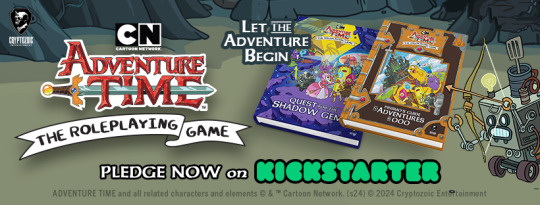
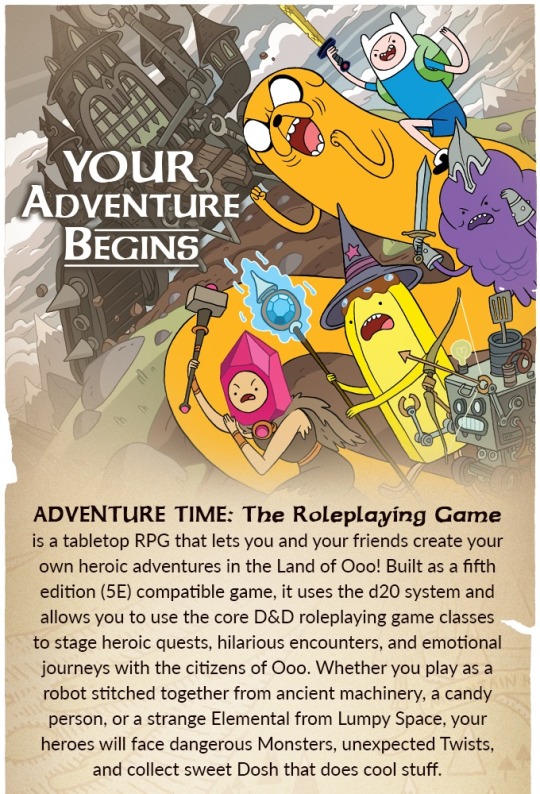

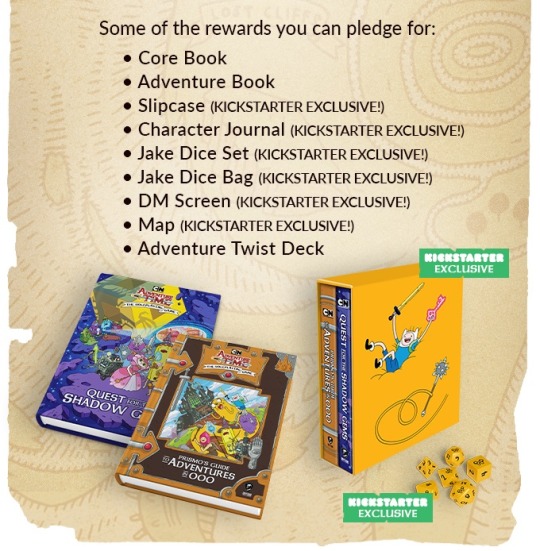

If you’re not familiar with 5E rules, don’t worry! Roleplaying games are about letting your imagination run wild as you create your own characters and stories. The rules provide support for your imagination and structure for your hero, but take a back seat to the FUN play at the table.
For those new to roleplaying games entirely, we are providing Jake’s Shmowzow Guide to Roleplaying Games with every copy of the Core Book exclusively on Kickstarter. It’s a simple guide to get any person started having fun with the Adventure Time RPG. Written by Ray Winninger, co-designer of the DC Heroes RPG and former Executive Producer of Dungeons & Dragons, the guide includes the needed core rules from the 5E OGL, a simple step-by-step explanation of the simple ideas you need to understand to begin play, and finally a walk-through of the character creation process. All guided by Jake!
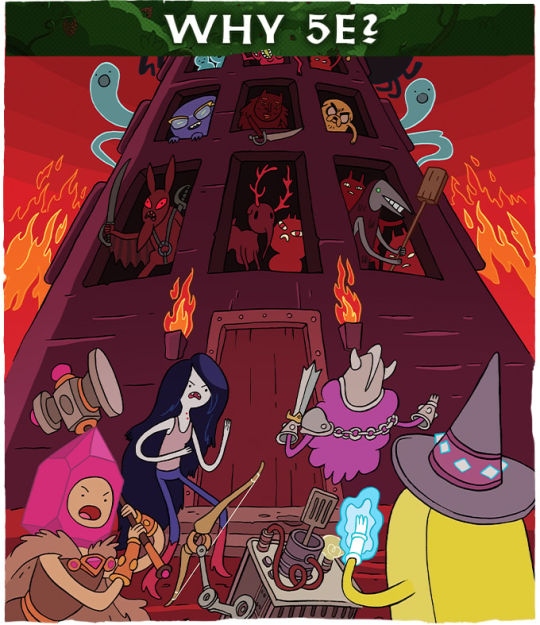
Adventure Time has its roots in the older editions of Dungeons & Dragons, with episodes and story arcs that grew from the pastiche fantasy adventure that the second and third editions laid out so beautifully. We believe that the high-quality design of 5E—and its very nature—are well-suited to capturing the open-ended excitement and sense of wonder that are at the core of Adventure Time. If Dungeons & Dragons gave birth to Adventure Time, using 5E for Adventure Time: The Roleplaying Game brings everything full circle and is true to the spirit of the series.
We believe that we can craft and implement the world of Ooo and the features of the Adventure Time RPG best in 5E, empowering you with the feeling that you can be any person you want to be and that anything can happen when you step out your door for adventure!


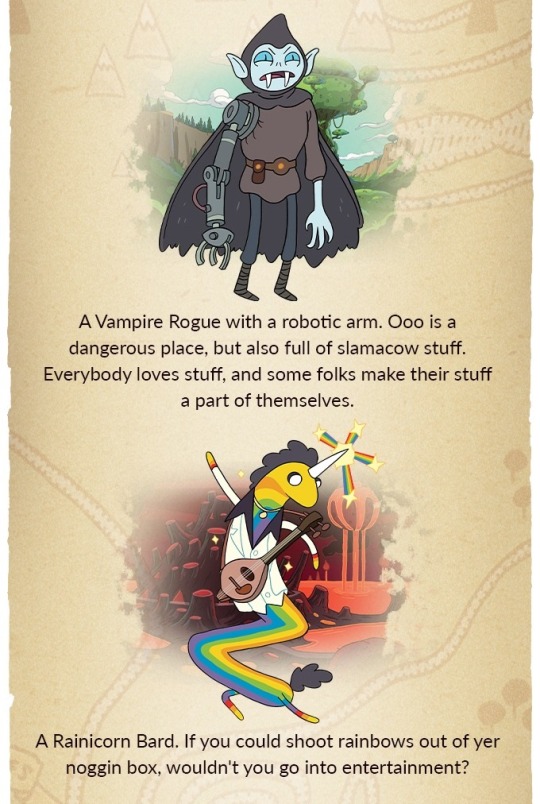
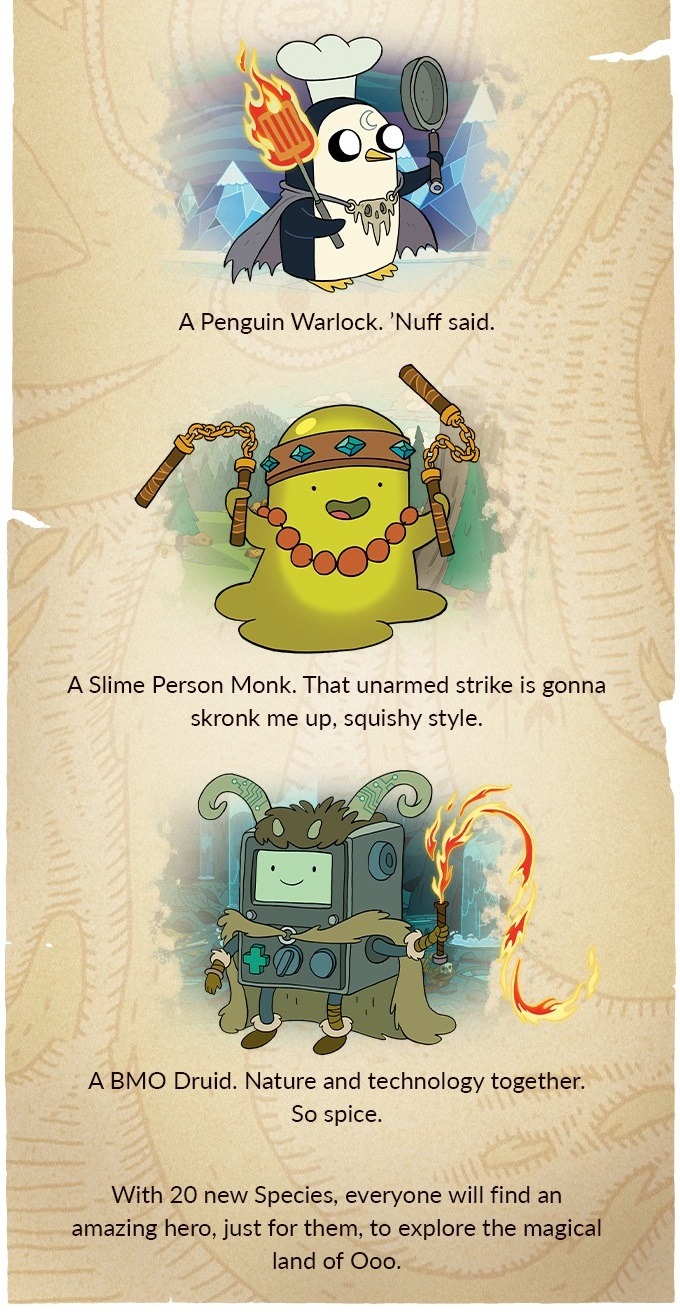

But how, exactly, do you explore Ooo? This is a tabletop roleplaying game built using the Dungeons & Dragons rules, basically. In fact, if you are familiar with those rules, you already know all about how to play Adventure Time: The Roleplaying Game.
If you’re not familiar with those rules, you don’t need to worry. Dungeons & Dragons is a game about letting your imagination run wild; it is a game that is played through conversation, is moderated by dice, and takes place in your cranial. As you adventure through the amazing land of Ooo, stuff will happen. There is a player, called the Dungeon Master, who will tell you about that stuff.
As a brave adventurer, you will want to respond to your Dungeon Master with awesome heroic actions. Your character will have a set of attributes and some skills and powers that provide options for those reactions. But you can respond however a person could respond (if that person was a Wildberry Person, with an axe!). However you respond, you will tell the Dungeon Master what you want to do.
Once you choose your action, it’s time to get mathematical with it. You will roll a twenty-sided die and add a bonus number to it, based on the attribute (or skill or power) that is most applicable to the action. If the total number is high enough to equal or exceed a target set by the Dungeon Master, you will succeed, and the skill or power will dictate the results of that action.
And that's all there is to it! Imagine what the Dungeon Master tells you, have a conversation with the Dungeon Master about what you want to do, and roll a twenty-sided die to see if it works. Three simple steps to exploring (and loving!) the Land of Ooo.
And we’ve got some sweet new mechanics to enhance your awesome RPG experience and fill it with Adventure Time!


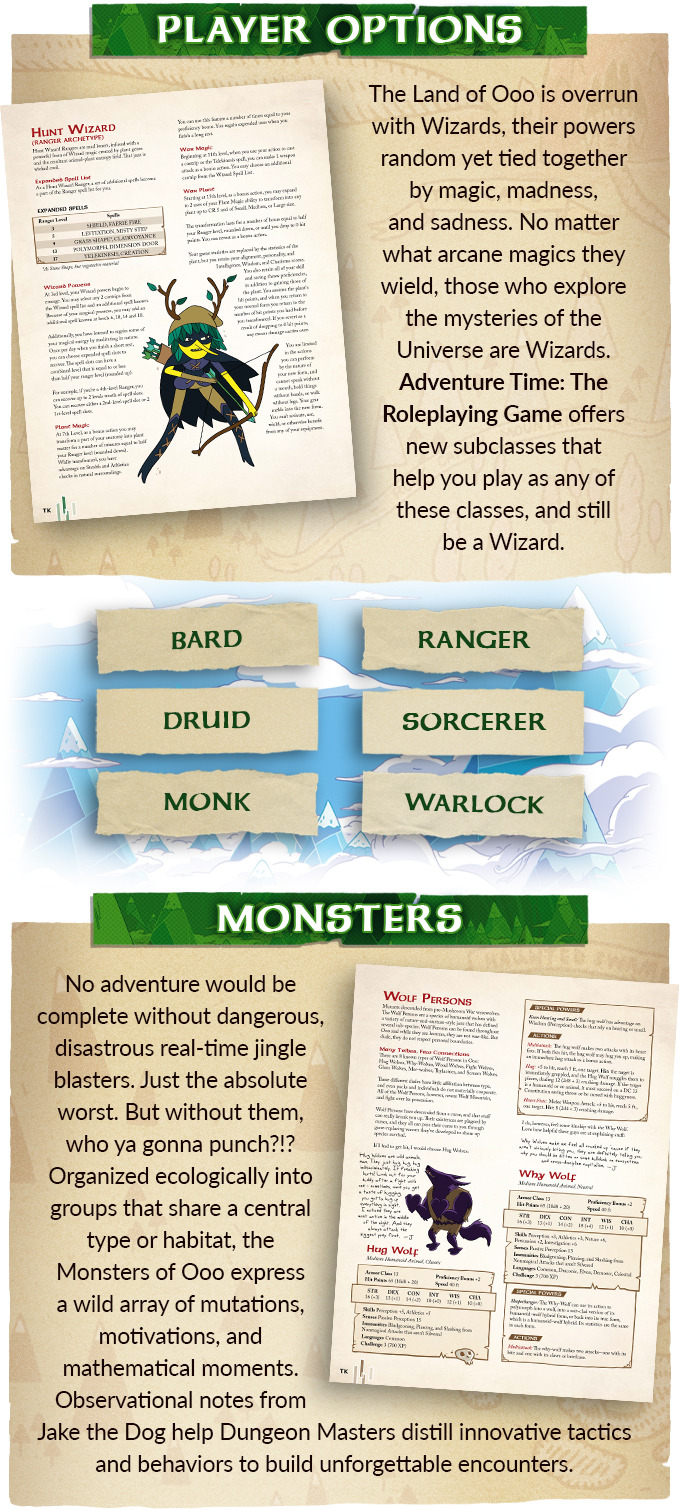

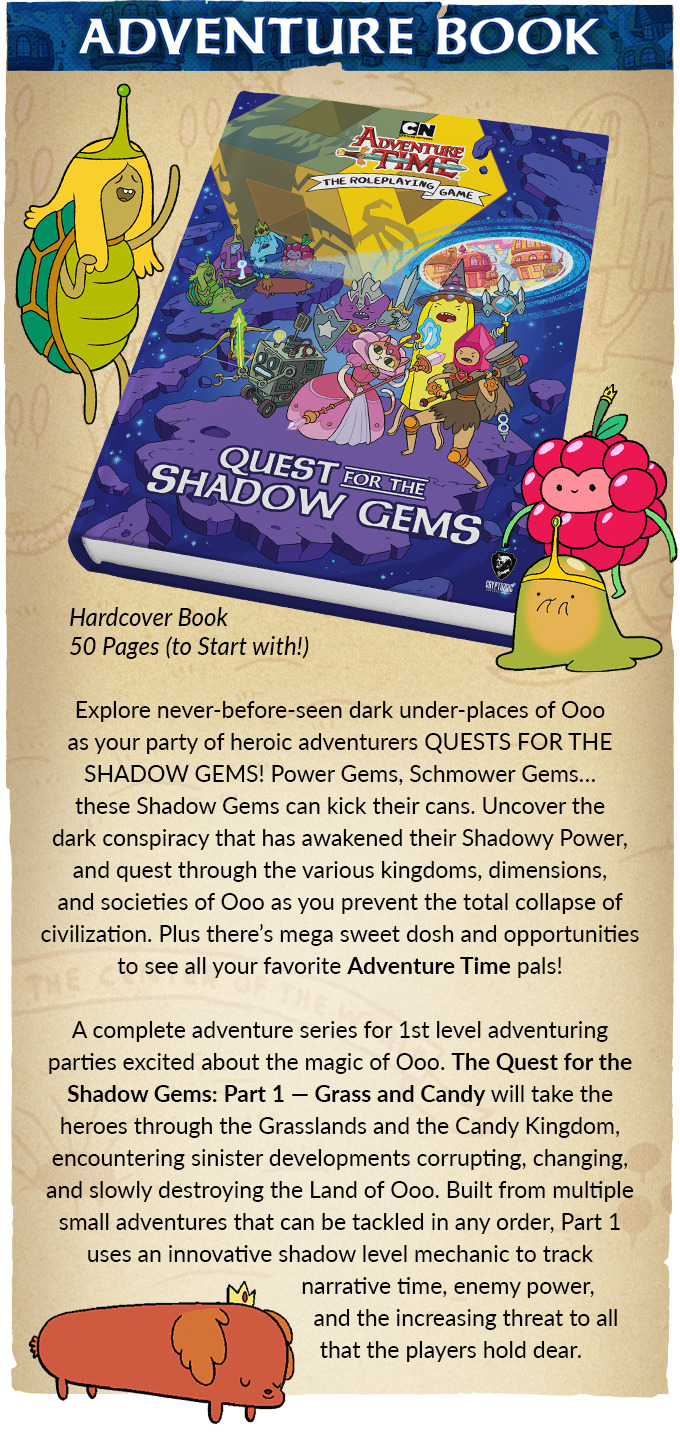
Kickstarter campaign ends: Wed, May 15 2024 8:00 PM BST
Website: [Cryptozoic Entertainment] [facebook] [twitter] [instagram]
38 notes
·
View notes
Text
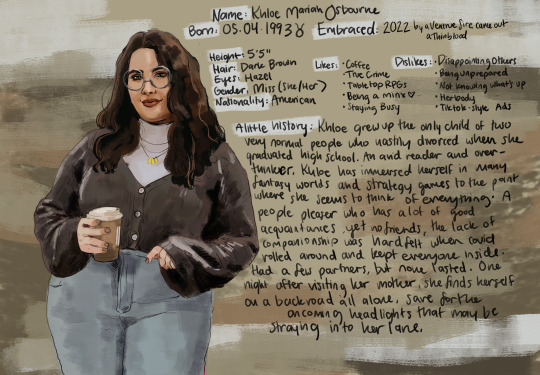

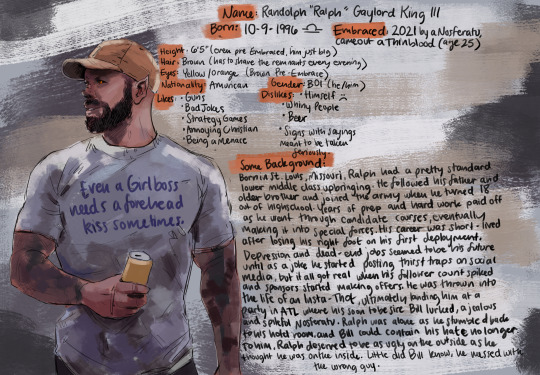

The Stakebait Coterie! Khloe and her boys are out there saving the Atlanta Waterbloods or get Final Death'd trying! (I'll type it all beneath the cut because I know.. my handwriting)
The main characters of the Poisoned Peach - ATL by Night chronicle my beloved is running for me! Khloe is my character, and the boys are my unbeatably dope team.
Name: Khloe Mariah Osbourne
Born: 05/04/1993, Embraced: 2022 by a Ventrue, came out Thinblood, Physical Age: 29
Height: 5'5", Hair: Dark Brown, Eyes: Hazel, Gender: Miss (She/Her), Nationality: American
Likes: Coffee, True Crime, Tabletop RPGs, Being a Minx, Staying Busy
Dislikes: Disappointing Others, Being Unprepared, Not knowing what's up, Her body, Tiktok-Style Ads
A little history: Khloe grew up the only child of very normal people who nastily divorced when she graduated high school. An avid reader and over-thinker, Khloe has immersed herself in many fantasy worlds and strategy games to the point where she seems to think of everything. A people pleaser who has a lot of good acquaintances yet no friends, the lack of companionship was hard-felt when COVID rolled around and kept everyone inside. Had a few partners, though none lasted. One night after visiting her mother, she found herself on a backroad all alone, save for the oncoming headlights that may be straying in her lane. (Where the Poisoned Peach begins!)
Name: Kyle Johnson
Born: 2/3/1994, Embraced: 2020, Sire unknown, but came out Thinblood, Physical Age: 26
Height: 5’10", Hair: N/A, Eyes: Sexy-Boy Brown, Gender: More man than your man (He/Him), Nationality: American
Likes: Feeling needed and helping others, Parties, Drinking cocktails with stupid names, Reasonable reactions.
Dislikes: Being late, people that CAN help and just don't, the MINIONS, Improperly labelled content warnings.
History: His mom was a nurse, her mom was a nurse, and so on. His sisters didn’t want to carry on the tradition, so he decided to go into the medical field himself as an EMT. The stress of the job brought on early balding, but he thrived both on the clock and in the club. One night, he drank a few too many and he woke up in a dumpster the next night, completely clueless. The sunlight began to hurt, nothing sat right in his stomach. Everything was the same yet all so different, better and worse. He spiraled, confused and depressed, until the Dusk Angel found him and helped him come to terms with his new existence. Now Kyle proudly helps the Thinblood Revolution as a kind face to help ease the new blood in, just as he had been.
Name: Randolph "Ralph" Gaylord King III
Born: 10/09/1996, Embraced: 2021 by a Nosferatu, came out Thinblood, Physical Age: 25
Height: 6'5" (Even pre-Embrace, him just big), Hair: Brown (Has to shave the remnants every evening, used to be long and thick and in a man-bun), Eyes: Yellow-Orange (Brown pre-Embrace), Gender: BOI (He/Him), Nationality: American
Likes: Guns, Bad Jokes, Strategy Games, Annoying Christian, Being a right menace
Dislikes: Himself :(, Whiny people, Beer, Signs with sayings meant to be taken serious.
Some Background: Born in St. Louis Missouri, Ralph had a pretty standard lower middle class upbringing. He followed his father and older brother and joined the army when he turned 18 right out of high school. Years of prep and hard work paid off as he went through candidate courses, eventually making it into Special Forces. His career was short-lived however after losing his right foot on his first deployment. Depression and dead-end jobs seemed to be his future until as a joke he started posting thirst-traps on social media, but it got real when his follower count spiked and sponsors started making offers. He was thrown into the life of an Insta-Thot - specifically Fitness Inspo - ultimately landing him in a party in Atlanta, Georgia, where his soon to be sire, Bill - a jealous and spiteful Nosferatu - lurked. Ralph was alone as he stumbled to his hotel room, and Bill could contain his hate no longer. To him, Ralph deserved to be as ugly on the outside as Bill thought he had to be on the inside. Little did Bill know, he messed with the wrong guy.
(Not written due to lack of room, we clearly don't play favorites here...) Eventually found in the sewers by the Dusk Angel, Ralph now serves in the Thinblood revolution, using every skill he's acquired in order to get revenge against the Fullbloods.
Name: Christian Ottavio
Born: 01/16/1989, Embraced: 2017, Gangrel sire but came out Thinblood, Physical Age: A rough 28
Height: 6'1", Hair: Dark Brown, Eyes: Brown, Gender: The MAN (He/Him), Nationality: American
Likes: Beer, Relaxing nights spent inside, Napping, His truck
Dislikes: His family, Wearing tight jeans, Bro-Country music, Fullbloods
A bit of background: Born and bred in Georgia into a rich family with ideals he couldn't wrap his head around. Went into the workforce at a young age in an effort to escape them and be on his own. He's had to sleep in his truck many a night, but eventually got everything together enough to get a roof over his head. That was until some uppity lick decided to draft him into the army of the damned during the Atlanta Sabbat civil war. He was one of many forced to fight during the schism, and one of the few to come out "alive." Before his sire could take him behind the proverbial tool shed, Christian was saved by the Dusk Angel, and now is a proud Thinblood freedom fighter.
#stakebait coterie#thinblood#duskborn#clan thinblood#clan duskborn#vampire the masquerade#vampire oc#vtm oc#vtm#world of darkness#my art#MY BABIES MY ANGELS OUR CHILDRENNNNN#vamily#coterie#khloe#kyle#ralph#christian#gotta do the DUSK ANGEL bio next lmaoooo#the poisoned peach: atl by night
77 notes
·
View notes
Text
Book 3 finished, and oh my god there is so MUCH
Many thoughts below
So my thoughts from finishing book 2 that this 3rd part would mark the true "conclusion" to this"first" story in the series was right on the money. Even in keeping with the "Pattern of 3" that's so prominent in the setting, book 1 literally ends on a draw, book 2 sees one success after another, while book 3 is where our "heroine" (villain? protagonist?) truly fails, in some big ways. As with many tales of woe, it begins with the Fae.
I've already hinted at comparisons to the Fair Folk from the Exalted tabletop rpg in a previous post, but it needs to be said MAN these Fae are REALLY SIMILAR to Jenna Moran's Raksha huh. To the degree where I was looking side eyed at some parts. They're not literally the same as Exalted's Fair Folk tho. Yes they're elemental themed but not in the same ways (more based on seasons than classical elements), yes they are less people and more magic receptacles for stories, but it's not like Jenna invented that interpretation of the fae. More importantly, rather than being completely anathema to Creation, they are more "to the side of Creation" and bare some unspecified connection to the Gods, their dwelling of Arcadia being like a prototype version of Creation. Plus in this setting mortals are also ruled by stories, just in the form of fate, the Named, and their Roles, whereas Fae are beholden to stories, to the point where it can completely override their will (good point to keep in mind for later)
Another point before I get into it, this book was LONG, to the point where it felt like two books in one. It's twice as long as book 1, so there's some truth to that. Not a point against it, just that it pretty cleanly divides the story between the "Arcadia arc" and the "Diabolist arc".
To start, the entire dealing with Arcadia was a nice mix of action and intrigue, culminating in an incredible duel, and later a fantastic series of battles that, far from being a side quest, proved to be utterly integral to the main plot, and Catherine's development. Her mantle of Duchess of the Moonless Night, and later of pretty much all of the (former) Winter Court, proved to be a drastic change in her very being that shows no signs of being reversed, unlike her "undead gambit" she used in book 2. The time for flawless victories has passed; every point of progress in this book cost her more, and more.
By the very end of the book it is not even clear whether she is still Named, in the traditional sense, but rather she is definitely more Fae than mortal, possibly full Fae even. She's so changed that wards designed to keep out the Fae now work on her, and she can feel thresholds and boundaries as tangible things that are difficult to deal with, even in relationships (oh I'll get to her and Kilian, don't worry).
And the oaths! Oh friends who know me know I LOVE me a good binding oath that borders on pathological (why I like fucked up paladins so much) I adored the bond she made with Hakram so much in book 2 he catapulted to my second favorite character, now here she makes at least three or four extremely juicy oaths, one which nearly ends her, and the rest we'll have to see later. And now that she's part/mostly/fully fae, those oaths are ingrained in her that she doesn't think she could break them if she wanted to.
Which is so fascinating, because alongside all of that, we see the first long term consequences of her actions, and the eroding of her moral scruples, of the lines she's willing to cross. While I had my arguments against during book 2, I think we can safely say by now that Catherine Foundling is indeed Evil, and not just in the sense of Evil being a faction, but down to how she views the world and treats others. That's not to say she doesn't care for anyone, or that she's just as bad as other villains (the Diabolist arc will rid us of that illusion), but she's definitely not a good person. But damned if that isn't a hard pill to swallow.
She wants to be a good person of course—her entire motivation jumpstarted off picking what she saw as the path of least harm. And then just overnight Akua, now the Diabolist, commits mass genocide on an entire Callowan city, turning 100,000 innocent citizens into her undead army, using a secret super weapon stolen from the Tower, and her own ghoulish designs, purely out of spite towards Catherine swearing to make her suffer beyond death if she harms them.
The horror and totality of that loss only gets to really hit her at the end following Akua's death. While this proves Cat has moral lines she won't cross that separates her from Diabolist—who literally tried to "not so different” speech at her because the audacity of this bitch—she still acknowledges her responsibility in the massacre, Akua's appointment as Governess of Liesse being part of her bargaining to beat her at the end of book 2, with the assumption that she'd be swiftly removed and dealt with.
Instead Malicia, as we find out in the aftermath, allowed Diabolist to build up her power base, in a gambit that she'd produce a weapon dangerous enough to deter Procer and the Principate from launching the tenth Crusade. This shatters Cat's trust, in Malicia and Black, that they tacitly allowed this to happen, and she wonders if she really chose the path of least harm if she's on the side that just might let a Callowan city get effectively nuked every other year.
What was most surprising was that this marked a fallout between Black and Malicia. While the Empress wanted to keep the weapon, and agreed to make Catherine Queen of Callow as part of reparations, Black sees it as a magnet for the biggest and strongest Heroes to come out of the woodwork and destroy everything they built. And I can't help but feel he's right, but also when he destroys the array controlling the weapon, that does ensure the Crusade is coming, and there will still be Heroes with them regardless. After a breaking of bonds where Cat stabs him in the stomach rather than kill him like he expected (a scar to remember me by), she is crowned Queen and prepares for war. Her connection with the Tower now frayed to near breaking, but the sheer cult of personality she's built keeps everyone in the fold.
Speaking of, I finally want to talk about her break up with Kilian. I went into book 3 still worried about their future. No longer the doubt that she could be a spy, that plot point does get wrapped up and none of the spies are known characters. However, the tension reaches a breaking point for our favorite couple when Catherine leaves Kilian (one of her senior staff) out of her senior staff meeting where she declares she's doing a spot of treason. Which Kilian later guesses it's cause she didn't want to risk Kilian threatening to break up with her in the meeting and throw off her game convincing her senior staff not to mutiny. Which, ouch. She feels like Cat doesn't trust her, just like how she left out Commander Hune too whom she doesn't trust (double ouch). AND she went into Arcadia without Kilian, a quarter-fae who could have helped, but she saw the non-Named as a liability (triple ouch). She offers the possibility of performing a blood sacrifice ritual that could turn her into full Fae, that would make her no longer a liability, which Cat staunchly refuses because she sees the practice as a disgusting disregard for life a "line she won't cross". They stop seeing each other for months.
I was dying to know the outcome of this fighting. I was one who wanted to see them make up somehow, if only cause it's rare to see a couple in fiction fight and make up, rather than break up immediately. Maybe it's cause I've only been in one relationship, that has lasted decades and seen us both through the best and worst of our lives, and we've made it work even though we don't always agree, or do/say the right things. But that makes me want to see people reconcile, I guess. So I assumed they would.
The chapter where they finally talk again is one of my favorites, tho very little of consequence to the story happens, but to Cat's and Kilian's character, very much. I don't know how many would be reading this that haven't already read through the series by now, at least to this point, but if you are you probably don't mind spoilers so I'd highly recommend reading this chapter which focuses on their talk, and eventual breakup. It requires little other context, and is such a good piece of prose exposing just how emotionally shut out our Catherine has gotten. I was as surprised as Kilian when she admits she'd used Kilian as a kind of refuge from the dark shit, so when Kilian made it clear she doesn't share the same ethics it felt like a betrayal, which wasn't fair to put on the mage. And then it makes so much sense that she'd be upset when Cat tries to turn this into a "so do you still want to do this thing I hate in order to be close to me" conversation.
Kilian, like Hune, isn't like the others that have been pulled into Cat's circle. She will serve as Senior Mage so long as the legion holds, for that is what she's the best at. But she has no interest in being "a horse you have to break or a hound you have to feed" to be a part of Cat's circle of Big Damn Villains. She was paramour to the Squire/Black Queen for a while, and she got left behind for it, when all she wanted was to be girlfriends with Catherine Foundling because she liked her, not the Name, and for a while was happy.
And isn't that the fucking tragedy of it all.
Kilian never wanted to break up, wanted to forget about the ritual and not see Cat use it to self-flagellate, to go on about how she's crossed lines so she shouldn't have held others to standards she doesn't meet. She wanted Cat to just be a person while it was the two of them, and Cat simply can't anymore. She's too afraid of failing, herself and everyone she's dragged with her, if she's not perfect in her vigilance, if she doesn't live up to the Name and titles given to her. And THEN after all that, has the GALL to say she loves her as she's saying goodbye which just breaks Kilian's heart 😭
You wanna know the best part? The very next chapter Cat has a debate with a priest of the House of Light about her definition of Evil. Cat says Evil refuses to play by the rules. Evil means seeing the powers trying to keep her controlled, tell her what to do or where to be, and decides she should be able to do what she wants, to live how she wants, and will kill for that right.
And the priest responds "I didn't think you would be so prone to fear," and Cat thinks she doesn't get the point??
Like, CAT. It's just like you were saying to your ex! And you don't see the connection there?? She really is losing her humanity, and the barometer for it was losing her connection with Kilian until they had to break up 😢
Needless to say I EAT THIS SHIT UP. Of all the most important lines Cat could have crossed, perhaps it's this one that's the most important.
Do I still expect them to make up? Not really, I think that ship has sailed. It would take a humongous amount of self-healing for Cat to be in an emotional position to be that vulnerable, and most importantly she'd have to forgive herself, which I don't see anytime soon. I almost wish Kilian moves on by then, for the added lesson of acceptance on top of that. But in the meantime we've got a lot more wars to fight and a lot more atrocities to commit, so that will have to wait.
See you all again after book 4! If I can finish before my post-surgery recovery is over (the only way I've been able to tear through these books so fast)
#a practical guide to evil#spoilers#book 3 spoilers#Honestly probably my favorite book in the series so far
5 notes
·
View notes
Text
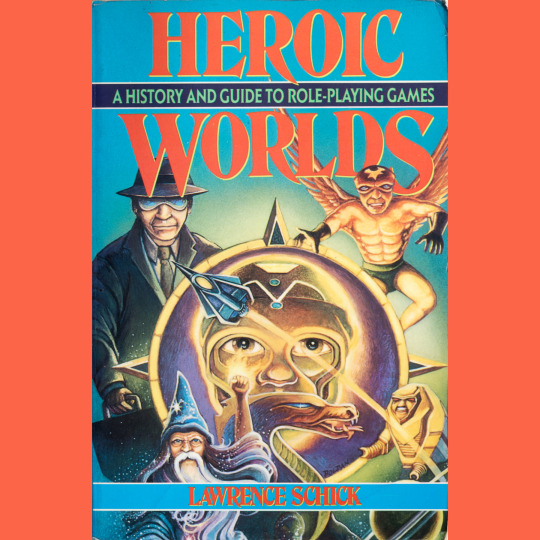
This is Heroic Worlds (1991), by Lawrence Schick (of White Plume Mountain fame).
There are a bunch of books from the ‘80s and ‘90s that attempt to catalog and review RPGs and they kind of boggle my mind (the same is true for the similar genre of print paperback tip guides for videogame). Even having lived in the pre-internet era, I don’t understand the rationale for these books from a publishing perspective. Which is not to say I don’t adore Heroic Worlds. I do! It just seems…improbable.
The book essentially amounts to an index of every RPG product produced from 1974 to 1990. It feels a tiny bit like an Overstreet Comic Book Price Guide (another publication I’ve always been baffled by), except without the prices (though there is a small section on collecting — the advice still rings true today, primarily: be patient!). The listings are interrupted periodically with short essays by a rogues gallery of RPG designers: Gary Gygax, Dave Arneson, Greg Stafford, Steve Jackson, Jennell Jaquays, Michael Stackpole, Ken St. Andre, Tom Moldvay, Ken Rolston, Sandy Petersen, Erick Wujcik, B. Dennis Sustare, N. Robin Crossby and Greg Gordon. That is a pretty all-star cast of characters talking about tabletop game design!
The main attraction for me, though, is Schick’s commentary. Nearly all of the listings are accompanied by very brief appraisals; they give Robert Christgau’s album reviews a run for their terseness. Schick has a dry wit that creeps into the capsule reviews that soon becomes addictive. And there is just something wonderful about having a period of time captured so exhaustively in a single volume. I don’t think EVERYTHING ever published through 1990 is in the index, but Schick sure makes the book feel like it does. I refer to it constantly for my Instagram posts, it was a constant companion when writing my own book and honestly, it deserves a lot of blame for the size and scope of my collection. Damn you, Schick!
(Repost from April 30, 2020; revised)
58 notes
·
View notes
Text
The history of the Dutch table top rpg 'Queeste'
A couple of days ago Joop Oele passed away. He was a Dutch tabletop rpg pioneer. I guess outside his hometown in the Netherlands hardly anyone has heard about him. To honour him, I send out this bit of rpg history about his game 'Queeste' out into the world wide web. Please reblog ( @vintagerpg ) This is an abridged version of a Dutch article I helped put together last year for fantasywereld.nl
Guided fantasy
It was 1979. Joop Oele and a few of his friends had never heard of anything like Dungeons & Dragons. They were experimenting with all kinds of games and role-playing games. At that time role-playing was used in therapy sessions. Joop and his friends turned it into games and a fantastic journey. In a group of people, there was one leader who initiated the game. They all started lying on the floor in a darkened room. Usually, Joop initiated the game by visualizing a landscape. There were no attributes or rules for the game.
Somehow a story always emerged in those sessions, a story created by the people who participated. It was like moving the magic glass in a spiritist session. The glass is moved by many hands without anyone knowing which way it will go.
Joop used this setup of the game for many years to come. Also, in game sessions with his son when he was about seven years old. Usually, they started in an air castle where they used a flying mattress to visit all kinds of places.
Another path that led to the development of Queeste was a line of wargames Joop developed called Dukes game. It was played on a large board with wooden units that had all kinds of abilities, represented by blocks of wood with coloured pins in them. For example, a unit had a certain speed, which could be increased by giving it a horse.
Another inspiration for Queeste was a game Joop had designed in 1978, the Labyrinth game. That game consisted of 49 rooms, laid out in a matrix of seven by seven. The middle room contained a rose, and was the final goal of the game. Each of these rooms contained a variable number of doors, some of which could only be opened from one side, and a person who asked a multiple choice question with as many answers as there were doors in that room. The correct answer led to a door that provided access to the room that led most directly to the rose. By giving correct answers, and imagining the labyrinth, you had to try to reach a final goal as quickly as possible.
Many elements of a TTRPG began to form from various sources of inspiration.
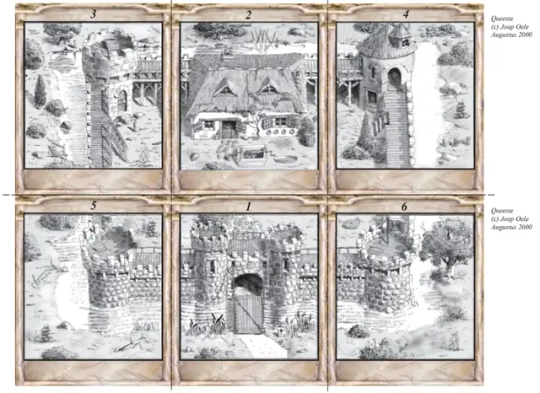
Queeste
Because Queeste was developed in isolation from other well-known role-playing games of the time, it had its own look and feel. Joop was also a graphic artist. He envisioned that you would have a picture of every location and every place you visited in the game. You could put those little drawings together to form a complete overview map of the area. It gives the first adventures an unprecedented eye for detail and focus on where you ended up as a player.
Instead of the familiar set of versatile dice, Joop didn't have much more at his disposal than the regular six-sided dice and coins you could toss. He developed a system where for a test with a property you could toss as many coins as that property counted points (+1D6). This immediately gave the game tactile value. Some players just love to have their hands full of chips (or dice) and throw them on the table with a dramatic gesture.
The setup Joop had in mind was not future proof. Drawing so many pictures was time-consuming. The detailed focus on the environment was also less necessary after the first few adventures. Most groups gradually switched to a more verbal dynamic. The casting with the many fishes also proved a bit clumsy. An auxiliary program was soon developed, for the Synclair ZX Spectrum.
The influence of guided fantasy can be seen strongly in the first quest stories. The players step into a world unknown to them: it is true portal fantasy, and with the way it happens it symbolizes how you descend into the more creative and intuitive part of your consciousness: The land of dreams.

Guilds and magic system
The game developed while playing with his group of friends, and not long after that came the guilds and stories. Joop did not develop these on his own. Joop came up with a number of guilds; including the Temple Knights, Sun Riders, Wolve Women and Druids. Of course, there also had to be Mages, but the game system for that was devised by Rob Meijer, who based it loosely on Ursula LeGuin's Earthsea. As players, you could weave your own spells using words from a magical language. All the guilds are beautifully and eloquently elaborated, and especially the magic system is unique. The players of Joop's first group had a lot of influence on the development of the game; both on the stories and the guilds.
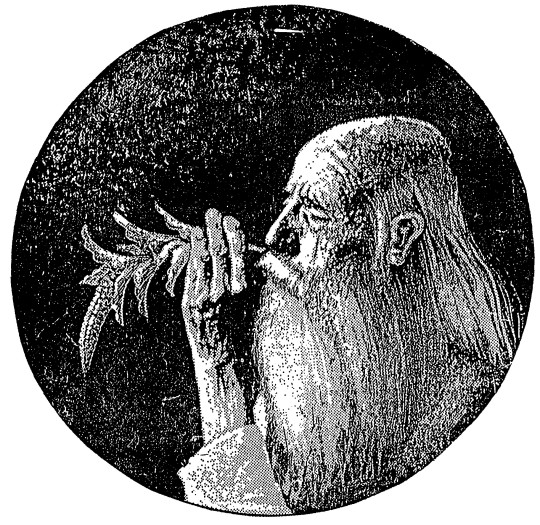
Joop started a game publishing company he called Knossos in 1979 with the material that had been created, and he marketed Queeste in a box. In it were the game rules, loose cards with the accompanying illustrations, a set of simple wooden chits and a die, and the first adventure Tocht naar de Onderwereld (Journey to the underworld). They were sold throughout the Netherlands, but particularly in the Nijmegen region, where Joop himself lived.
Not long after the first box, the second adventure, Grint, a charming booklet appeared in A5 format. A little later, the third adventure Tigris appeared in A4 format. This was the format in which Joop published the magazine Queeste. The magazine contained Queeste adventures, as well as background information and additional game rules. The adventures Oosterterpe, Sardon and Slotmar appeared in that magazine.
It soon became apparent that publishing the game was not a great commercial success. And drawing all the pictures and publishing the magazine was time consuming. In fact, each group played much faster than Joop would ever be able to publish adventures. Every group that had bought the Queeste box, without having a direct line to Joop themselves, had to make up their own adventures to continue.
In the 1990ies all the rules and storybooks for Queeste were re-edited and published to make the complete campaign and ruleset available for future players. The pdf’s are still available as online download.
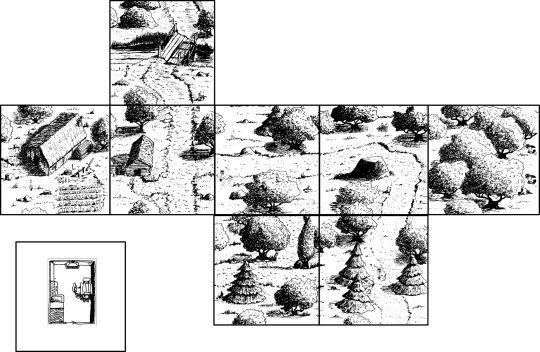
3 notes
·
View notes
Text
Dogmatic Dungeon Master
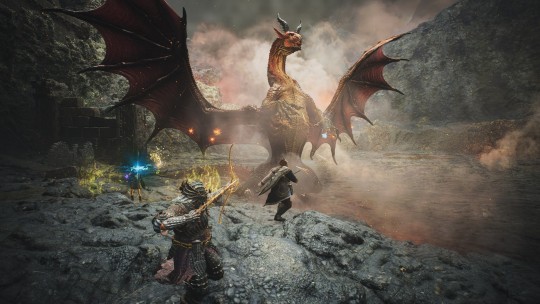
The last four weeks of my gaming time were consumed by Dragon's Dogma 2, an extravagana that's something like experiencing a wild D&D campaign that keeps going off the rails over and over again. (I'm pretty sure Capcom would be pleased with this comparison, seeing that they released promo art heavily based on AD&D's classic Red Box.)
DD2 has been a delight to devote 100+ hours to, and I find myself wishing I'd bought its predecessor ages ago, especially during those Steam sales where it sold for ridiculous prices like three or four dollars. I never did because I thought it looked sort of generic. Joke's on me! To be fair, this second one could also be described as looking generic upon first glance (though Capcom's RE Engine is certainly proving that it's got legs since Resident Evil 7), but I feel like that was an intentional decision. The goal here was clearly to create something with the trappings of the iconic Western fantasy setting (plus the inclusion of cat people, AKA Beastren) to draw players in and get 'em comfortable before presenting them with one of the most wacky open worlds in recent memory.
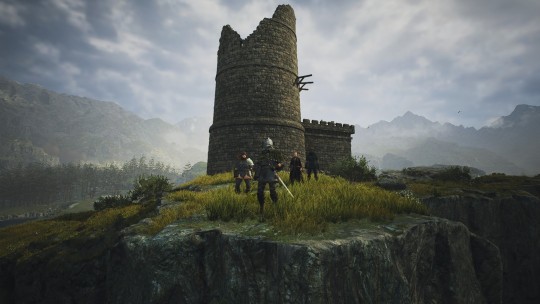
How's it wacky? Well, DD2 has a billion different systems under the hood, all colliding with each other. There are the systems that dictate the schedules of NPCs, who you can find wandering roads and getting into fights with enemies. Said enemies have their own systems, and on more than one occasion when I was fighting one of the game's huge bosses (drakes, golems, minotaurs, ogres and the like), that fight spilled over into the territory of another boss, who proceeded to attack both me and the first boss. A kaiju rumble ensued as the systems of both bosses collided with each other, and sometimes this rumble veered too close to the borders of a settlement, attracting the attention of pawns, which are basically the sidekicks assisting the game's main character, the Arisen.
If you're playing online, pawns created by other players can randomly appear in your game, and there were many special moments when I ran into a bizarrely off-proportion thief with the incredible name "Frog Nasty" and a half-naked mage dubbed "Lucy Liu." On one such occasion, Frog and Lucy joined my ever-evolving kaiju battle, and the incredible chaos continued until a griffin just happened to swoop down from the sky to snatch me up in its arms. As I went in the sky, I proceeded to climb atop that griffin’s head and smacked it silly with my mace until it dropped me into the ocean where I was devoured by Brine, AKA DD2’s in-world explanation for why you can’t just swim everywhere.
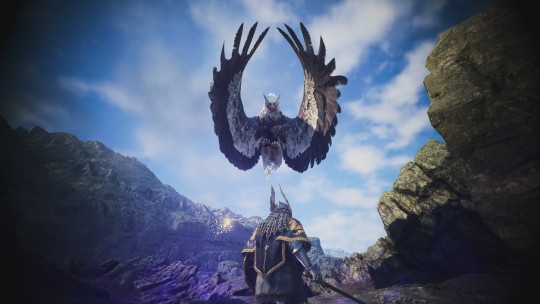
My description of this incident is no exaggeration. Unscripted mischief of this ilk happens every five minutes in this game, and it's the result of all those systems smashing into each other with delicious gusto. That said, not all of the systems work as well as they should, and some are half-baked. For instance, there's a romance/affinity system that's a carryover from the first Dragon's Dogma. The affinity levels of characters are never truly explained, and you can unexpectedly cause random people to fall in love with you by giving them the right gifts again and again, or completing their sidequests at the expense of others. This means that the Vernworth tavern keeper, who plays no important role at all, can suddenly show up in the final cutscene as your true heart's desire, in the clutches of your mortal enemy. I guess even when DD2's systems are half-baked, they still yield entertaining results.
As someone who runs a lot of tabletop RPGs (but often doesn't get the chance to act as a player), Dragon's Dogma 2 truly reminds me of a dedicated Game Master who doesn't mind when players test limits. This is a GM who clearly loves madcap battles full of unexpected twists that can take up an entire gaming session, as well as expansive side quests with more flavor than anything else in the campaign. The main story is not said Game Master's preference, which serves as a handy explanation on why you can find many Reddit threads decrying DD2's plot as kinda blah.
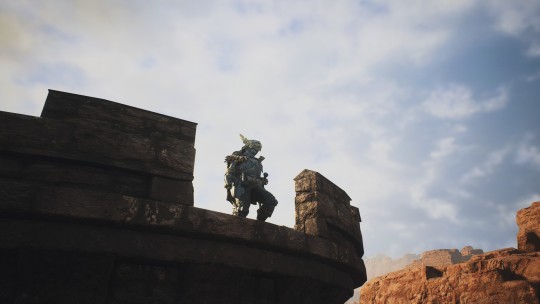
I get these complaints. The game's main missions are not terribly long - 40 or so hours, probably - and the clear meat of DD2 is in the exploration and combat. This isn't to say that the story's total rubbish, as it does have poignant moments in its cyclical, meta take on an Arisen who rises up every couple of years to complete a destiny of fighting the titular dragon. There's a secret endgame that also delves even farther into the tabletop RPG comparisons, giving you the chance to "defy the Dungeon Master," if you will, sending the campaign even further off the rails as you potentially see what happens when the GM just has no shits left to give and decides to turn the world into an apocalypse.
All of this makes DD2 probably one of my favorite open world games. I've been thinking a lot about what sort of open worlds attract me, since I'm a firm believer that more often than not, video games don't need to go all massive. (Give me a small-scale, well-developed area over a massive map filled with junky quest markers.) That said, I've noticed that I like open worlds that buck the Ubisoft-style trend of having busywork for really good writing (The Witcher 3 comes to mind) or simply invest in their mechanics to the point that everything fills up like a wonderful sandbox, with lots of bits and bobs to play with (that would be The Legend of Zelda: Breath of the Wild).
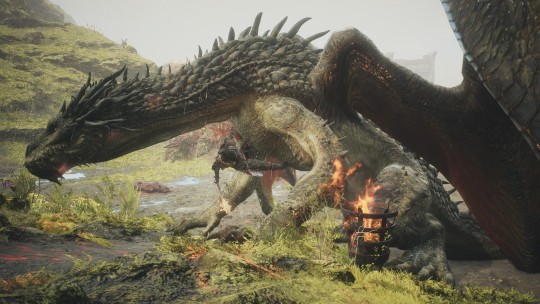
Dragon's Dogma 2 is definitely more on the kooky sandbox side of things, with its oversized monsters at every turn and wonderous pawn shenanigans. The true appeal of this game, however, lies in the little stories that you create with your main pawn and other pawns along the trail. There's something special in the relationship you forge with these AI allies, who aren't real in the slightest, but bring forth that feeling of being a Game Master yourself as you corral them into taking down a drake. I was downright emotional when I said farewell to my main pawn at the end of the game (okay, the fact that I designed her to look like my wife probably helped, but still).
So here's to Dragon's Dogma 2, a wild piece of entertainment commandeered by a Game Master who clearly loves the journey more than the destination. Here's to those moments when you and your loyal pawns are facing down an ogre in its lair, or just barely survive a golem's laser beam after a series of hobgoblins stunlocked you into low health over and over again. Here's to sitting by a campfire, enjoying an unpredictable open world, and realizing the grand truth that comes with all tabletop RPGs - that the unscripted moments truly are the best part of the adventure.
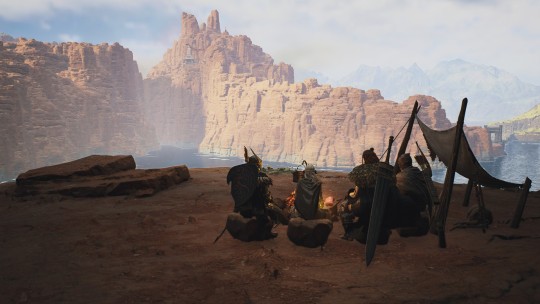
10 notes
·
View notes
Note
I feel like one of the fundamental issues that comes up when people argue about DnD being queer (or basically any DnD-related discourse) is that we don’t really have good language to distinguish the game of DnD, as in the stuff in the rulebook, from a game of DnD, as in a given session/campaign in play. Like there’s certainly a point where people are just willfully misreading the text but also I do think that, since we talk about those two things using basically the same terminology, it’s not that surprising that a lot of people have a hard time recognizing the difference between them.
That's true, there is a difference between D&D as the text or the product as sold by Wizards of the Coast and D&D as the experience being partaken by various people all over the world, which is a transformative experience derived from the former. The latter can definitely be queer, but I think even that reading isn't on the most solid foundation.
Cause the way I see it, it is definitely possible for a queer group to play D&D in such a way as to include things in the game that relate to their queerness, and in many ways that could be seen as a queer experience. But the extent to which D&D the game brought in any of the queerness is effectively zero. The queerness isn't in the game itself, it's in the act of transformation, and that transformative property isn't something that is uniquely applicable to D&D. Even when talking about D&D as a queer experience it is still a matter of attaching the identity to a product that doesn't do anything unique with it. A game of queer Rolemaster is equally divorced from the text as queer D&D and the queerness is entirely in the reading and the act of play.
Also, as I keep saying, for most discussions of D&D, the text is the common ground we have. We really can't have a meaningful discussion about the queerness of D&D as an experience as a whole, because there's no way for us to account for every table's experience. And secondly, and most importantly, if we think of D&D as a queer game simply because it could be theoretically transformed into a queer game by its players it becomes effectively meaningless, because that is true of every tabletop RPG in existence.
But yeah, I'm basically applying the same metric to the discussion of the queerness of D&D as I am to the rules of D&D: I really don't care what goes on at each individual table because I simply can't observe all of them at once. But what I can do is look at the text and go "that sure is a thing that the text says."
52 notes
·
View notes
Text

Do your words bring life or death? 💔
Shockwaves of political intrigue were sent out across the world of Terrath as the Lux Imperium finally claimed victory in the Siege of the Spires war, defeating the dreaded Scaled Legion orcs. Enterprising races across the globe flocked to entreat favor, trade agreements, and religious collaborations with the new war hero, Father Geno. One such dignitary, emissary Felix Stonesong traveled from the deep places under the earth to represent his Iridia crystalline people's interests in the new political landscape. As Father Geno opens his doors to new foreign political allies, might his greatest threats still loom … from within?
HeroesOfProvidenceEternal.com – Get free ttRPG maps, begin your own LEGEND, and become the hero you were born to be!
WATCH our complete comedy adventure short series Tourist in Terrath! "Pulled through a portal to a fantasy land, Bob from earth is an every man, trying to get home before he gets killed, join our hero Bob for a weekly thrill!" CLICK HERE
JOIN Captain Tumult on his journey to rescue his one true love from the monsters of his past! Action! Romance! Mystery! Revenge! Your free tabletop RPG adventure on the high seas awaits! HeroesOfProvidenceEternal.com/saber
EXPERIENCE our epic swashbuckling pirate fantasy audio drama on: YOUTUBE or PODCAST
GET your copy of CARDtographer - our epic storytelling card game for legendary heroes at: CARDtographer.com
FOLLOW us on all our social media: Linktr.ee/HeroesOfProvidenceEternal
SUPPORT us on Patreon for more adventures! Patreon.com/HeroesOfProvidenceEternal
#storytelling#rpg#dnd#BattleMap#WorldBuilding#dungeonsanddragons#ttrpg#DungeonMaster#fantasymap#tabletoprpg#DnDmaps#pathfinder#FantasyMaps#fantasy#rpgmap#tabletop#map#battlemaps#tabletopgames#fantasyrpg#RPGmaps#maps#FantasyArt#dndmap#roll20#dndhomebrew#rpgs#crystalfolk#crystal#Shardminds
4 notes
·
View notes
Text
Persuasion, or, another RPG rant
So! Social mechanics. One of the many, many common pieces of tabletop RPGs. Obviously this exists for the two reasons of players not having the same abilities as their characters and to simulate stuff that isn't really possible to make a matter of plain roleplaying.
The thing is, persuasion in TTRPGs most of the time involves a single group of outcomes: Making other characters do what you want. Because things are simplified, if it were as easy as just "Roll die or dice, get whatever result you want" it would feel a whole lot less like persuasion and a whole lot more like mind control. Heck, the debate of "Is this functionally persuasion or mind control" is absolutely a thing in some circles. Looking at you, Storyteller Revised games (Not WoD revised edition, Scion 1e/Exalted 2e. Yes, it's confusing.)
One of the ways I've seen games navigate around this is by making it limited what a single persuasion roll can actually do per se. This is where you've got your D&Ds, your Chronicles of Darkness 2es, and your Exalted 3es. (Incidentally, Exalted 3e's social system is one of my favorite social systems in existence. The system has its flaws but the social-fu is great.)
Even with the "You can't make other characters do anything too crazy" rule, you also get into other cases where that rule does exist, but people ignore it. Some of that, I'm guessing, is cases where people minmax the crap out of social systems and expect it to scale; and on paper this makes sense. If Gorgrath the Mountain Crusher rolls 30 over the DC of a task to hurl a boulder, that thing should be a twinkle in the distance right? So logically the same should hold true for social systems. If you knock the ball out of the park, you should be able to convince other characters of wilder and wilder things.
...Except that doesn't translate from the angle of "What does this part of the game do exactly?". A boulder being thrown might affect one part of the plot or another, but how far it goes is often fairly incidental compared to what you can actually convince a character especially a major character to do to say nothing of horror stories resulting from persuasion being used on other player characters.
In the end, "Boulder go far" doesn't have the same potential to make things go sideways as much as "This character hangs on my every word". So a system that expressly forbids the kind of gonzo scaling that might be expected from smashing the difficulty check in a D20 system into next Tuesday, like Exalted 3e, Exalted 2e on paper, or Chronicles of Darkness is pretty necessary.
So as implied, "Persuasion is like mind control" situations mostly come up when those implied or explicit rules are allowed to be broken. Changing the rules on the fly is obviously possible, but the responsibility for that in my opinion falls mostly on whoever's running the game whatever two or three letter acronym you're using. If someone allows that to happen at their table, on their chatgame, Discord RP server, or whatever venue that is in my opinion a game runner problem... Or someone acting out in a way that's gonna get retconned fast.
3 notes
·
View notes
Text
OC Intros: Patchwork Melody
(Remaking this since the OG post was really only accurate for their first meeting and I've had a lot of fun expanding their relationship beyond that point. Also the OG formatting sucked sorry I'm bad at this)


Patch (They/He/Any but It) is an extremely anxious, mute borrower, (by trade, not species) with the saddest wettest backstory possible, to maybe be told later. Their story starts when they find themself being "aided" (captured) by a human who thinks of them as the poorest, cutest little creature in need of a guardian. Since they can't vocalize, and their writing system is radically different from the one used by humans, communication is a problem. Over time, they begin to work through their trauma around humans, helped as their relationship with this newest human changes over the course of a few years, from captor to friend to partner.
Patch isn't their real name, but it's a nickname given to them since they can't exactly say their real one. Their true name is something of the big mystery of the story.
Melody, aka Mel (She/They) is a huge fan of the supernatural and paranormal who stumbles upon a weak and fearful little fae-looking creature one morning, and takes it upon herself to be their caretaker and guardian. Her sometimes off-putting and overbearing personality makes the start of this newfound friendship a bit strained. Over time, Melody takes a massive level in kindness as she learns to respect her new friend's boundaries, and starts to appreciate Patch as a person rather than a spectacle.

Five Fun Facts about each of them:
Patch:
They're allergic to citrus fruits but don't understand allergies (Doesn't everybody think oranges are spicy?)
Their favorite foods are strawberries and chocolate. Discovering Neapolitan ice cream was basically the highlight of their life.
Totally normal about television (It lets them see so much of the world… they've only ever lived within like three city blocks). Easily the best way to get their mind off things is to set them in front of a nature documentary.
Their backpack and scarf were gifts from their parents, and are their most prized possessions because of that. The backpack is actually made of denim, so it's (relatively) extremely durable.
Actually a skilled poet and wordsmith… not that it's readable to humans. Their specialty is a form of poem similar to a haiku that has the same number of characters on every line.
Melody:
The red eyes and iridescent hair are (obviously) contacts and dye, her natural eye color is a hazel and her hair is a very light brown. Seeing her without contacts confused the hell out of Patch the first time.
One of those kids who went hard for Halloween as a kid, they dressed as various fictional wizards every single year, and only stopped when they went to college.
Actively tries to follow fae rules and superstitions when talking to strangers, even before meeting Patch. One of those people who gets genuinely anxious when a customer service person says "May I have your name?"
She has a degree in classical mythology and folklore. Needless to say, it doesn't get much use other than putting them in debt.
Owns a Switch but only sometimes plays RPGs and strategy games. They'd be a massive Tabletop RPG buff if they had any friends to play with…
12 notes
·
View notes
Note
Hey, I'm sorry if this isn't entirely your wheelhouse but do you know any ttrpgs which have players as bug aliens? Not like "human with different stats and a shell", but full on nest-building/flesh-eating/genuinely alien bug aliens? Sorry again if this is a bad ask/something you've done before.
THEME: Bug Aliens
Hello friend! Many folks seem to feel unsure about whether or not they are asking incorrectly - I want to assure you that I welcome all kinds of asks, and you don't have to worry about asking for something that might have been asked before - it just means that I get to either revisit games that I think are interesting, or add more games that I didn't talk about last time! Let's get started.
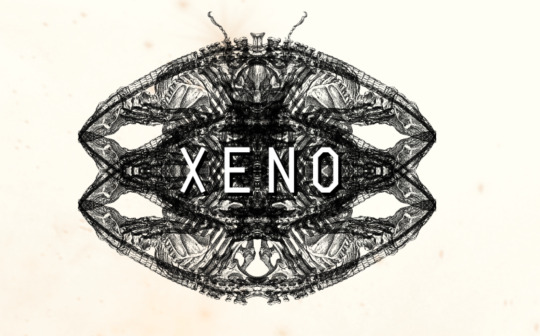
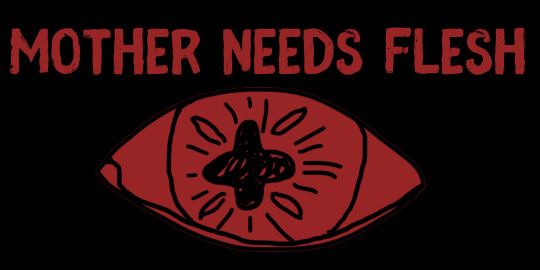
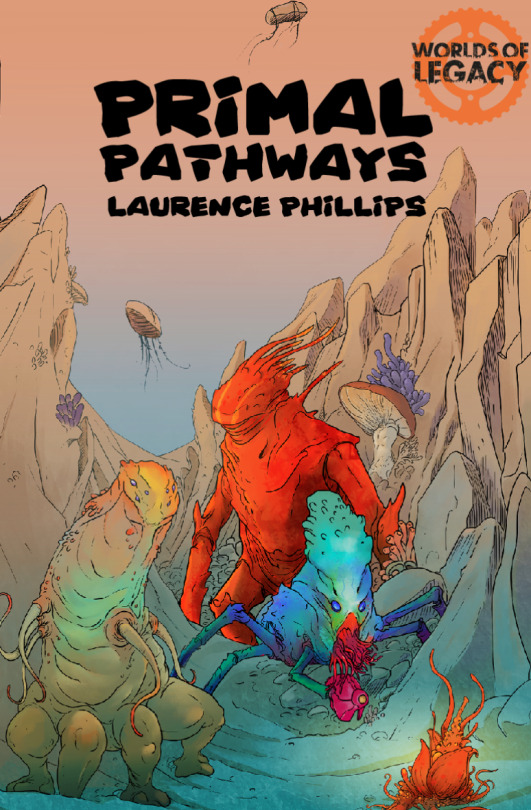
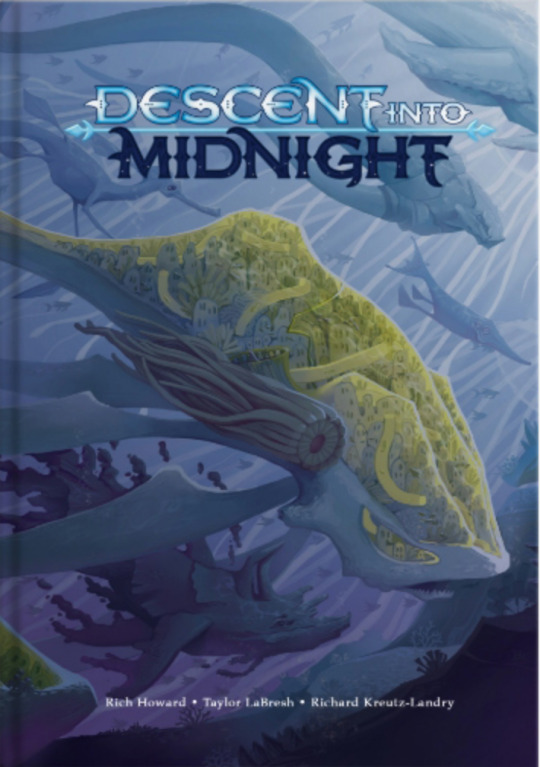
XENO, by Caligaes.
XENO is a role-playing game where you take the role of a monstrous ALIEN who arrives on Earth with the sole objective of claiming a new OPPORTUNITY.
From 2 to 5 people (including the Alien Master) can enjoy a ONE SHOT where they will feel like true monstrosities destroying everything in their path. To start your invasion you need this document, 4-sided dice (called d4), a pencil (or pen if you're brave), and a sheet of paper to take notes of your mission.
There is nothing that really decides what kind of alien you are here, only that you are one - so go and fulfill the directives of your ship’s AI and cause psychic strife while you’re at it, and be as buggy as you can be! This game uses only d4’s, and everything fits on a brochure, so it’s easy to print this game out and give everyone a copy. Go forth and wreak havoc!
Mother Needs Flesh, by JoPa
MOTHER roams the galaxy searching for ways to satisfy her hunger. You, her Scions, operate to fulfill her needs. Most of the time, you’ll infiltrate spaceships and moon stations, seeking to end all life aboard so MOTHER can feed on the flesh of your victims. Other times, you’ll forge alliances with pirates and planets to keep MOTHER safe. At dire times, you’ll help MOTHER fight off spacecraft seeking to destroy her. No matter what you do, you do it for MOTHER.
MOTHER NEEDS FLESH is a minimalist tabletop rpg for up to four players and one Game Master. All you need is four, six, eight, ten and twelve-sided dice plus pen and paper to play.
The game sets out the premise that Mother is a fleshy creature that travels through space, and that you are your Scions. There’s not a lot about what your Scions look like, so I think making them bug-aliens is do-able, although you might have to re-flavour some of the lore or moves to really immerse yourself in that kind of game. This is absolutely a horror game, and your characters will be finding humans to rend and feed to Mother, each feast making her (and you) potentially more powerful.
The game system for Mother Needs Flesh is Breathless, which uses a deteriorating dice system. Your dice re-set when Mother mutates or when you Boil Blood, but you’ll start with a d10 or d8 in most things, and that dice will deteriorate down in size with every roll that you make. It’s a neat and concise system, it fits on 2 pages, and it gives you that thrill of being absolute monsters.
Primal Pathways, by UFO Press.
On the harsh shores of this young planet, a new creature crawls out of the primordial ooze to face the forces of evolution.The pressures it will face are far more than natural: Guardians, enigmatic entities from another plane of existence, have seen fit to guide the evolution of a selected few young species.
As new generations rise and Civilisations emerge, what shape will your people take under their Guardian’s guidance?
In this biopunk setting supplement for Legacy: Life Among the Ruins 2nd Edition written by Laurence Phillips and illustrated by Juan Ochoa, you will create a new species and guide its physical and social evolution from the birth of civilisation to the stars. (The core rulebook is required to play.)
This game is unique in that you actually play on two different levels. On one level, you are Guardians, entities that are bigger and more abstract than a singular species. These Guardians will favour and guide the evolotion of smaller Species, out of which you will create individual members who create new stories. This game might be more suitable for a play group where different players have diffferent kinds of themes or goals they want to explore.
If you want to play a bug alien, the Parasite or Devourer might be a playbook that works for you. Other players might want to pick up the Builder or the Otherworldly instead! You’ll track the evolution of your species and decide what kinds of paths they take - the Devourer might priotizize a Hive Society or evolve into an Apex Predator. Meanwhile the Parasite might become raiders or establish an alien culture of spying. If you like the idea of moving between two levels of narrative and two modes of play, then this game might work for you!
Descent into Midnight, by Rich Howard, Taylor LaBresh, and Richard Kreutz-Landry.
Descent into Midnight is a Powered by the Apocalypse tabletop roleplaying game where the players take on the role of alien psionic creatures who are defending their home from an otherworldly corruption. In a game where sapient krakens and microscopic krill can create a complex society, how strong or dextrous you are isn't as important as the social, emotional, and existential impact of the actions you take. Descent into Midnight is a game about connections, so the statistics used to describe your character describe your relationship to yourself, your team, and the people around you.
This game is meant to happen on a completely alien planet, and your character options are vast and endless. It’s not specifically designed for bug-aliens, but you can 100% make it about bug-aliens, complete with nests and a hunger for flesh. In fact, you don’t even have to create a physical character - your character can be the Concept of Oxygen, or The Environment That Houses All.
That being said, the game does focus on protecting a society from corruption - this means that while the game absolutely has a focus on horror and decay, the idea is that in a campaign game, your characters will be working to fix the problem, rather than making it worse. So I’d say that in terms of concept, it might give you something of what you’re looking for, but tone-wise I’m not sure if it matches what you’re thinking. Regardless, this a gorgeous and captivating game that’s worth looking into.
If you want a peek into what kind of possibilities exist in character creation, you can check out Character Creation Cast’s episodes on this game!
37 notes
·
View notes